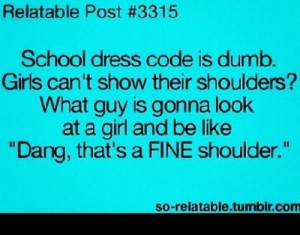Esther Cepeda, a former high school teacher, published an article to The Washington Post regarding a good reason in her opinion why school uniforms and dress codes are extremely important. The author claims that dress code ends the “disrupted educational atmosphere and constituted threat to the health, safety and decency of all students” that wear inappropriate clothing (and she stresses yoga pants multiple times in the article). “Enforcing the dress code was a nightmare.” Cepeda continuously states how she hated having to put up with students that “put up a major fuss when you sent them to the dean’s office to cover up.” Although she did not enjoy enforcing the dress code, in her eyes, a strict dress code was a strong necessity in all schools because how else were gentlemen supposed to learn when there is a girl strutting her stuff wearing tight yoga pants around school (Cepeda)?
Cepeda mostly talks about how young female student’s bodies, that she experienced at the school she taught at, are the distraction to men and faculty that led to the need of enforcing a dress code. “Teachers have to play avert-the-eyes in order not to inappropriately eye students.” She speaks as an experienced teacher that found enforcing the dress code worth the hassle if it meant less of a distraction to people.

I think Cepeda’s argument that a dress code stops the disruption and distraction of the learning environment is an overgeneralization fallacy because, based on what she points out about female distraction, school dress codes don’t get rid of the distraction but only cover it up. When Cepeda says inappropriate clothing disrupted peoples focus, it is evident that she believes a dress code or school uniform will solve the problem of the human body and public profanity as being seen as a distraction. I found it kind of ironic that she only mentioned how females caused a distraction to other students. Being a female herself, Cepeda should understand that dressing a certain way is not always meant to be set as a distraction. For example, woman nowadays dress nice because they are confident about themselves. As for yoga pants, what Cepeda said about women wearing “bun-baring yoga pants to school” as provocative clothing, was ridiculous on its own. Most people wear yoga pants either because they are comfortable or that is the first thing they find in the morning to wear, not because students are out to seek attention. 
Again, schools are set to prepare students for the real world and college. In the real world, there aren’t any dress codes or mandatory uniforms unless your job requires it. Cepeda’s article was humorous because of the way she put down woman. She makes it seem as though men do not violate any dress code by focusing so much on woman and her choice of words sham woman’s bodies such as “bun-baring” “strutting their stuff” and “provocative.” Even if a strict dress code or school uniform was enforced to every school, that would not get rid of men or women checking each other out in a sense (sad but true).





